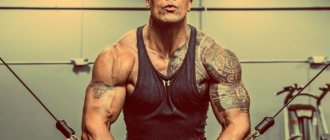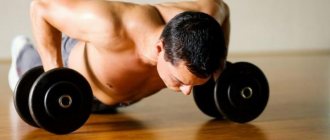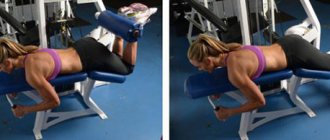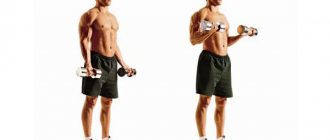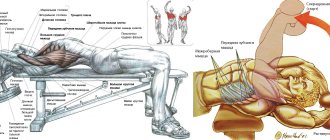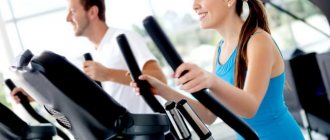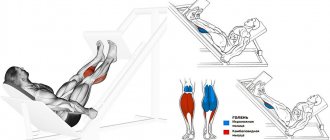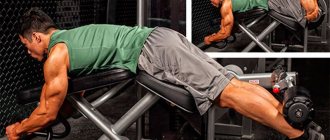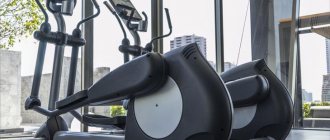What kind of simulator is this?
Sport is an integral part of our life. Thanks to him, we can achieve a beautiful and fit body and gain self-confidence. There are many opportunities for this in the gym. I include a multifunctional butterfly simulator in my clients' training. You can use it to perform exercises with different amplitudes, work the back of the delta and the pectoralis major muscle, tone your body, achieve relief and proportionality. The “butterfly” evenly forms and develops muscle tissue.
Designed like a seat with a back and two handles. Adjustable in height of the bench and width of the rests for the correct positioning of the hands. Using the simulator, you can imitate the exercise of raising arms with dumbbells, but get a more effective result. The main advantage of the design is that when performing a workout, the load on the back is significantly reduced. Thanks to convenient adjustment, the device can take different positions.
additional information
- Despite the fact that the developers talk about its versatility, it should still be noted that it does not work all muscles.
- The product weighs very little.
- It is compact.
- It has an affordable price, but this applies to regular models. Professional-level models have a fairly high price.
- When performing exercises for the arms and chest, calluses and unpleasant painful sensations may appear.
Contraindications
Regarding contraindications, it is worth considering the important point that you should not overload the body unnecessarily. Before deciding to exercise using a butterfly, consult your doctor for advice to rule out any possible side effects.
Health-related problems include:
- fragility of blood vessels and capillaries;
- presence of diabetes mellitus;
- hypertension;
- cardiovascular diseases;
- the presence of a cancerous tumor;
- skin diseases of infectious nature;
- the presence of wounds and ulcers on the legs.
Adviсe
- When performing physical exercises, muscle tension should coincide with exhalation, and relaxation with sigh. Proper breathing is the key to a highly effective workout.
- The number of repetitions of the same movements should be calculated so that you make the last movements with effort.
Errors
Many women do not do exercises regularly and leave them for lack of time or desire. This is considered a big mistake, since the expander will not bring any results in this case.
What muscles are being worked?
Using the “butterfly” we work on the large and small part of the pectoral muscle in conjunction with the shoulder, anterior deltoids, latissimus, trapezius, and rotator cuff muscles.
Benefit
- The pectoral muscles acquire proportionality, stretch well, and a clear definition appears, especially for those who work on weight.
- The exercise helps to effectively work out the deep areas of the chest and restore the tone of the upper body.
- There is a uniform load, as well as a separation of the right and left pectoral muscles.
- Blood circulation increases, which leads to muscle growth.
- “Butterfly” is useful for girls and women - the exercise tones the breasts and increases their elasticity.
Harm
If the training is performed incorrectly with jerks and “bouncing”, or failure to maintain control over the apparatus, the risk of injury to the joints increases. It is necessary to monitor your breathing, select adequate weights, follow the technique, keep your back straight, your shoulders parallel to the floor, and your shoulder blades retracted. You can't throw elbows.
Exercises for the abs
To work your abdominal muscles, use the following exercises:
You need to lie down, place your feet on the stake, knees bend. The first handle of the butterfly is located between the legs, the second is fixed with the hands. The projectile head is looking. Raise your legs, squeezing the apparatus and simultaneously straining your abs.
- The simulator is applied to the wall. Step back and stand on your knees at right angles. The distance from the body to the wall should be approximately a meter. Tilt your torso, bend at the waist and stretch your arms towards the floor so that your elbows are at a right angle. Stay in this position for a couple of seconds.
- Attach the projectile to the wall. Turn your back to him and take him from above. Squat down on your knees and pull it so that your elbows move towards your knees. Having dropped as far as possible, tighten your abs and hold.
- The projectile is mounted on the wall at chest level. You need to stand sideways to it and grab the handle. Now turn your back and move a little. Return to the original position.
- Attach the product to the bottom of the wall. Take a pen and stand sideways. Step back a little and make a movement similar to chopping with an axe, turning your torso as you do so. For the second side, do the same.
Technique for performing exercises in the Peck Deck simulator
- The hand pinch works the pectoral muscles, having a positive effect on their middle areas. If we change the emphasis of the load, we will use such parts of the chest as the top or bottom. To perform it correctly, we need to set the optimal weight, adjust the exercise seat and grip with our hands on a soft support so that the shoulders and shoulder joints are at the same level. We place our feet on the floor, press our back tightly against the bench, bend slightly in the thoracic region, grasp the vertical handles of the machine, position our forearms correctly and smoothly spread our arms to the sides, feeling an intramuscular burning sensation.
- Reverse flyes develop the posterior deltoids. This is a more effective exercise than bent over dumbbell swings. Before performing the exercise, we set the optimal weight and adjust the seat height. We place our arms at the same level as our shoulders, straighten them and fix them parallel to the floor. We press our chest against the back of the machine, keep our back straight, and bend slightly in the lumbar part. We grab the handles with our hands so that our palms are facing inward. We keep our arms bent. We make movements along the trajectory of the circle, to the sides and take the original position. The elbows should be fixed parallel to the floor, without lowering them down. Feel that only the shoulder joint is involved.
- We set the required weight and make sure that the machine settings are correct.
- We sit down in the exercise machine, put our chest forward, and lean against the back of the exercise machine. We press our feet into special cushions so that our body becomes motionless.
- We grab the handles with a grip on the same line, hold our arms parallel to the floor and bend them slightly at the elbows.
- We move our arms back, exhale, and keep our arms tense. The deltoid muscles should be contracted as much as possible, bringing them as close to each other as possible.
- We strain the deltas to the maximum, pause at the peak point and return to the starting position. We observe the number of repetitions and repetitions.
What grip should I use?
Depending on a particular simulator, there are several positions for the hands (grips).
As far as I remember, there is a STRAIGHT (where the hand holds the handle parallel to the floor), see photo below:
REVERSE (the hand holds the handle parallel to the floor, but not as in a direct grip, but upside down, i.e. the thumb is on the bottom, that’s why the grip is called reverse), unfortunately I didn’t find a photo...
TURNED TO THE SIDE (the hand holds the handles with the palm down):
And perhaps some other one provided for by one or another design (simulator).
Ps Straight and extended grips are most often used.
If in many exercises, the grip can play a decisive (extremely important) role, then here, in my humble opinion, the grip is not so important, because the connection with the deltoids (shoulders) occurs through the elbow joint, accordingly, at what angle you have your hands will be there (what grip you use) doesn't really matter (at least in my opinion).
However, many athletes use their grips differently, why? => for two reasons, firstly, who is more comfortable (more convenient), and secondly, who feels the rear deltoid better. That's all.
So try what’s more comfortable for you, where you feel your rear deltoid better, and use that grip!
Example of training with the Pek Dec simulator
Chest workout:
- Warm-up: perform 3x20 delt rotations, then do bench press with an empty bar - 2 sets of 10 reps.
- Bench press - 3 sets of 10 reps.
- Incline Bench Press – 3 sets of 10 reps.
- Reduction of arms in the pek dek simulator - 3 sets of 12 repetitions.
Shoulder workout:
- Warm up: first delt rotation 3x20, then push-ups 2x8.
- Military standing press - 3 sets of 10 reps.
- Dumbbell lateral raises (dumbbell swings) - 2 sets of 10 reps.
- Pulling your arms back in the peck dec machine - 3 sets of 12-15 repetitions.
Back muscle training
As mentioned earlier, the previous exercises with the butterfly machine are universal and involve not only those muscles indicated in the title. The manipulations that are most effective for a specific area of the body are described separately. However, you don’t have to limit yourself and use others.
For the first exercise, a lying or standing position is suitable, but for greater effectiveness it is still recommended to stand. One handle of the expander must be attached to one of the sides, along the body. Next, you should raise your hand on the side to which the exercise machine is applied. Then bend it at the elbow and the second handle of the “butterfly” will be located parallel to the forearm. Place your hand on top and begin to lower your forearm toward your hip, working the inside of your elbow. You should return to the starting position with the same force.
Tips for implementation
- Perform fly-ups, moving your elbows behind your back as much as possible - this way you will effectively work your deltoids.
- Feel the tension in your rear deltoids, not your arms.
- Proper technique requires keeping your body straight.
- Place your elbows behind your back, do not chase huge weights.
- Don't lift your body off the bench.
- Keep the rear deltoid muscles tense as you return to the starting position.
- For effectiveness, perform three sets of 12-15 repetitions.
- Watch and study the video, which explains in detail the correct technique.
Exercise Butterfly on a simulator for female breasts
To achieve an ideal figure and further maintain your parameters, you need to exercise regularly, eat right and lead a healthy lifestyle. There are many types of workouts for different parts of the body. One of the great ways to keep your pectoral muscles toned is an exercise with the interesting name “Butterfly”, which is performed using a special simulator.
General information about the exercise and the machine
This simulator got its name due to the fact that its action is similar to the flapping of the wings of a butterfly. Its main function is to work the pectoral muscles. These exercises are especially useful for women to prevent loss of attractiveness of the breast area. The zone is subjected to careful and thorough study, so the simulator will become an indispensable item during daily training.
The simulator looks like a block with a pair of levers. To perform the exercise, you need to bring your hands together. If you work out in a gym, the exercise machine will have a back, a seat, and bolster cushions to make it convenient to place your elbows. A special feature of exercises with this simulator is that it works exclusively on the pectoral muscles. All other parts of the body are not involved, but are in a state of rest.
Why are the exercises done?
The use of this simulator is not in vain very popular. This is due to its wide functionality. The main goal of the classes is to engage the pectoral muscles, both internal and external zones, as well as the shoulder zone. When the arms are brought together, muscle tension occurs, which contributes to the formation of relief. Working out the pectoral muscles helps tone a woman’s breasts, and its line becomes clear. Stretching the muscles improves blood circulation. Many people perform this type of exercise to recover from fractures and injuries. The back is strengthened.
Setting up the simulator and technique
To set up the simulator, you should set it according to your height so that the width of coverage is ideal for the practitioner. The technique of performing the exercises is quite simple:
- You should sit on the exercise machine.
- Place emphasis on the back so that the back fits tightly and there are no gaps left.
- Hold the handles firmly.
- Slowly bring your hands together.
- Hold this position for a few seconds.
- Slowly spread your arms.
- Repeat the exercise eight to twelve times.
There is another option when the arms are bent at the elbows. Here the first points are identical, but there are further differences.
- Before you begin to bring your arms together, you need to bend them at the elbows.
- Try to bring your elbows together.
- Stay in this position.
- Dilute slowly, not forgetting about proper breathing.
To work your back muscles, you will need to move the handles to the rear position. It is necessary that the handles are at the height of the practitioner’s shoulders.
- Your arms must be kept straight.
- It should be pulled back slowly.
- With maximum retraction of the shoulder blades, fix the position.
- Repeat ten to fifteen times.
Safety precautions must be observed. Do not lift weights that are too heavy as this may cause injury. There should be no sudden movements, as they can cause muscle rupture. Everything should be done slowly and smoothly, without jerking. In addition, the hands must be firmly fixed to the machine.
Conclusion
An ideal figure is the result of long and hard work. Easy butterfly exercises will help you work your pectoral muscles and keep your body in great shape. Exercise will help you maintain muscle tone and preserve the natural beauty of your breasts. It is enough to perform them three times a week, the result will not take long to arrive.
Pros and cons of this exercise
Unlike other chest exercises, chest curls have many advantages.
- When mixing, the load at the top point is not lost. That is, when we bring our arms together, our pectoral muscles tighten even more. This is because they are subject to the counterforce of the simulator itself. Which is trying to spread your arms apart. To prevent this from happening, we have to keep our pecs in constant tension.
- Suitable for athletes of any level of training. Exercise machines were specifically designed to make it easier for us to perform heavy exercises. Therefore, both beginners and professionals can do hand pinch.
- There is no work of the pressing muscles. Since we are not squeezing the weight, but trying to bring our hands together. We exclude muscles such as triceps, serratus and deltoids from work.
- The ability to pump the middle part of the pectorals. This is one of the few exercises that allows you to feel this area.
- Less chance of injury. All due to the lack of vertical load on the elbow joint. That is, the weight does not press on him from above.
As you can see, this exercise deserves to be included in your training program. Although it has several disadvantages.
Why use a butterfly?
First of all, this movement is used as a shaping one: with constant use it gives shape to the pectoral muscles - it expands on the outside and increases mass on the inside. One pectoral muscle looks like a uniform cushion - this is the result of working with this exercise. But, again, this is an isolating exercise. This movement alone “will not fill you up.” Therefore, you first need to tire your chest with basic exercises.
For girls, this exercise is an excellent help for the formation of a natural muscular corset of the chest, especially if the female breast is large. I think girls understand what I mean. Or, on the contrary, are your breasts too small? Then, in tandem with a bench press, for example, or with a dumbbell bench press, you can slightly increase chest volume due to muscle growth in this area.
When to use?
As I said, the “butterfly” is used after basic exercises, but often programs are structured in such a way that triceps are also pumped with the chest on the same day, which also includes basic exercises. So after what should you do the wiring in the block simulator? Naturally, after basic chest exercises, and then move on to triceps exercises, although they will be basic.
Subscribe and be the first to know about new articles on the site, right in your email.
Hi all! And the butterfly’s wings are clack-bang-bang-bang, and behind it the sparrow is jumping-jumping-jumping-jumping :)… No, the author of the project has not lost his mind, it’s just that today we have a technical note about the butterfly exercise of the same name. As usual, we’ll get acquainted with the muscle atlas, its advantages and, of course, practical tricks and secrets of performing hand contractions in the simulator.
So, take your seats, let's start broadcasting.
Safety
Under no circumstances should you place your elbows further than your shoulders . This is very dangerous even for healthy joints, and if the athlete has a history of shoulder injuries, then such a movement can quickly remind them of them. Also, this should not be done in the first workouts, when the chest muscles are still too weak and cannot stretch well. In this case, the desired effect will not be achieved, but the risk of dislocating the shoulder or straining the muscles will increase.
During the reverse movement, in the negative phase, you should not relax the chest muscles and “throw” the handles back . This will significantly reduce the load on the chest and reduce the effectiveness of the exercise itself. In addition, the risk of shoulder dislocation increases.
It is important to remember that this exercise does not involve stabilizer muscles, so you should not set the maximum weight. No one can back you up, so if one of the muscles “fails,” injury becomes inevitable.
